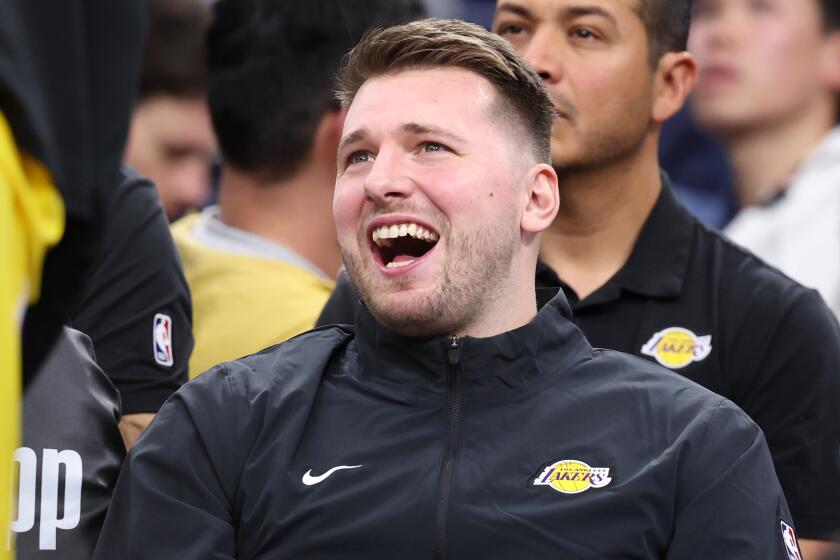Notre Dame’s Toughest Opponent Isn’t Michigan : College football: Book charges Holtz with misconduct and puts Irish football in a bad light.
- Share via
SOUTH BEND, Ind. — These are unsettling times for football’s most storied college. Wake up the ghosts at Notre Dame and what pops out are the skeletons in Coach Lou Holtz’s closet.
Look a few years ahead and see the Fighting Irish fighting the bottom line, to the point of very likely adding at least 20,000 seats to a grand old stadium many thought would never be altered.
Under normal circumstances, Notre Dame trying to stay Notre Dame in the face of gender equity and costs outgaining revenue would be the compelling issue here. And school officials may soon get back to worrying about the future.
However, an unscheduled opponent has suddenly appeared during preparations for today road game against third-ranked Michigan: a book called “Under The Tarnished Dome: How Notre Dame Betrayed Its Ideals For Football Glory.”
The Fighting Irish are used to criticism. It comes with the territory, trying to occupy the high moral ground of sport while also being successful in the down-and-dirty action on the field. Just this week, a poll cited Notre Dame as both the most popular and the most unpopular team in college football.
Authors Don Yeager and Douglas S. Looney give Notre Dame a good scolding, but the main target of their 299-page attack is the man in the middle of the cover--Holtz.
Much of the damaging anecdotes and issues involving the 56-year-old Holtz have been touched on before in public. In “Under The Tarnished Dome,” however, each charge has an identifiable person attached to it.
At the bottom of Page 22, for instance, former Notre Dame offensive lineman Chet Lacheta is quoted as saying about Holtz: “First he grabbed me by my face mask and shook it. Then he just spit on me.”
On Page 57, former defensive tackle George Marshall is asked if there was any way that Holtz could not have known about steroid use at Notre Dame. Marshall’s reply:
“He knew about it, but it was just that no one knocked on his door, came into his office and said, ‘Coach, I’m using steroids. I need help.’ Or, ‘Coach, I’m using steroids. What do you think?’
“Because it was like, if it wasn’t actually formally addressed to him, like his name wasn’t on a letter, he didn’t have to open the mail. He didn’t have to deal with it. So he didn’t.”
*
There are specific charges about Holtz’s ethics as the Minnesota coach in 1984 and ’85. “In the spring of ‘85,” the book says, “Holtz handed star recruit Roselle Richardson two $100 bills after he was told the recruit had lost his wallet during an official--and legal--visit. . . . “ That’s a violation of NCAA rules.
The book says Notre Dame lowered its admissions standards for football players after Holtz was hired in 1986 and is specific on Page 215: “Shawn Smith, George Williams and Chris Zorich are just a few of the players who told the authors that their academic credentials fell short of those usually required for admission.”
Notre Dame has countered with orchestrated silence. Holtz has repeatedly said: “I have not read the book. I do not plan on reading the book and I’m not going to answer questions on the book. This is not easy for me to do, but in fairness to our football team this is the way this is going to be handled.”
Meanwhile, the players have been told not to discuss any aspect of the book, including how the controversy surrounding it has affected their--or Holtz’s--focus on the Michigan game.
All comment about the book comes from the Rev. E. William Beauchamp, the university executive vice president, who during a an interview Thursday often repeated parts of the statement he’d written when queries first surfaced:
“In the most recent NCAA study, Notre Dame football players’ graduation rate was 85%, a figure matched by only two of the 298 colleges and universities surveyed. In the same survey, Notre Dame has the highest graduation rate (90%) for African-American football players.
“Notre Dame also has complete confidence in its pioneering drug-testing program, as well as its policies regarding athletic injuries. . . . Notre Dame conducts routine exit interviews with graduating athletes (and) the vast majority of the 250 or so players who have finished their eligibility under Coach Lou Holtz are positive about their experiences at Notre Dame and emphatic that they would choose Notre Dame over again.
“Coach Holtz has done the three things Notre Dame asks of any coach--he has lived by the rules, his players have graduated and he has fielded competitive teams.”
Beauchamp added: “We’re proud of our program; we’re proud of Lou Holtz.”
One of the Notre Dame players critical of Holtz in the book was offensive lineman John Askin. In a letter to Athletic Director Dick Rosenthal, Askin said he felt “betrayed” by Yeager.
“I was never worried about my interview because I was assured and promised that my quotes have to go through my approval to be printed,” Askin wrote. “Also, I have Don Yeager on tape saying this.”
Yeager’s editor at Simon & Schuster, Jeff Neuman, said, “My understanding is that is not the case.”
*
Notre Dame’s pre-eminence among football-dominated schools was emphasized by its decision to remain independent when nearly everyone else in Division I-A joined a conference.
Penn State couldn’t go it alone. Neither could Miami nor Florida State.
By arranging a five-year deal with NBC to have its home games televised, Notre Dame indicated it could.
That’s in football. Beauchamp is less certain about staying independent in men’s basketball, saying: “We’re comfortable as an independent, but it’s a changing scene out there. That’s something we’ll continue to look at.”
Most of the 21 other varsity sports, men’s and women’s, are aligned with a conference.
So how does all this get paid for? Notre Dame is close to unique in that the net revenue from the athletic department goes to the school’s general fund. All bowl money and a large amount of the NBC-generated television income goes toward academic scholarships.
“The last two years, among bowl money, the NBC contract and licensing and marketing,” said Beauchamp, “we’ve increased our endowment for scholarships by close to $18 million.”
Still, Notre Dame is not immune to scholarship and travel and lodging costs rising at twice the rate of inflation.
Rosenthal is a former banker inclined toward using three dozen words to say costs will outstrip revenues within about four years “if nothing changes.”
“We do not solicit contributions for athletics,” he said, meaning Notre Dame has no athletic booster club. It does seek corporate tie-ins for many of the modest revenue producers called “Olympic sports.”
“You should look at the stuff we reject,” Beauchamp told the magazine Notre Dame News.
“At most away games, corporate sponsorship is more common than uncommon. But to what extent does it take away from the mission of the educational institution? . . . “
Such questions are being asked during debate over whether to expand the 59,075-seat Notre Dame Stadium to about 80,000. Built in 1930, when Knute Rockne was at the peak of his popularity, the place has an aura like none other in college football. Why tinker with a shrine?
A decision on expansion will come “within a year,” Beauchamp said. Probably, construction would take another two years. And like all else about Notre Dame football, everybody will charge in with an opinion.
More to Read
Go beyond the scoreboard
Get the latest on L.A.'s teams in the daily Sports Report newsletter.
You may occasionally receive promotional content from the Los Angeles Times.










